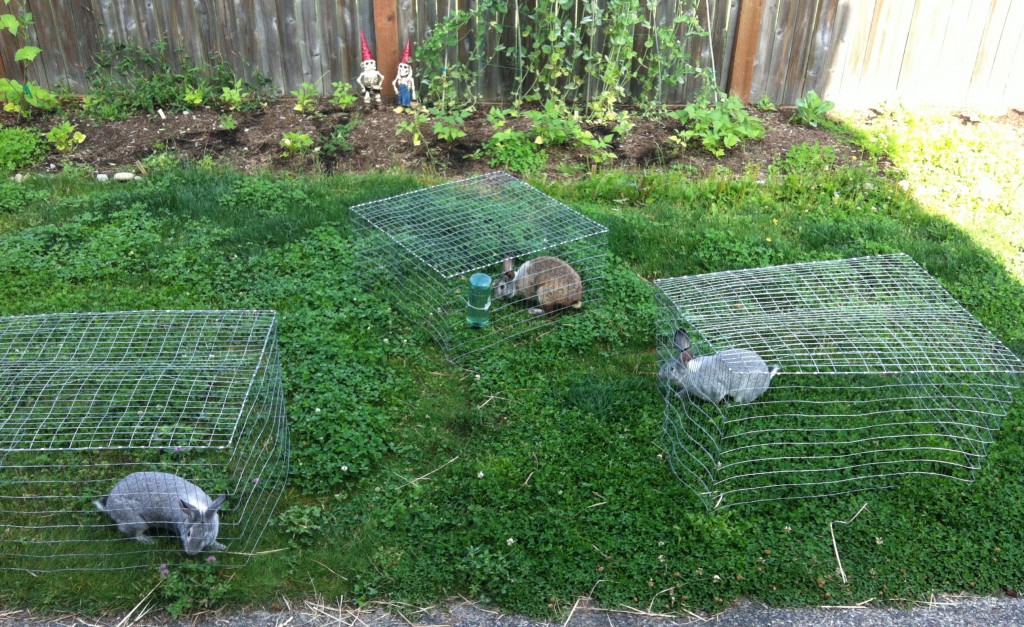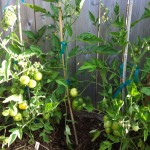Prior to leaving on our vacation to Colorado last month, Ryan and I tried to get an automatic watering system for the rabbits in place. While I had never worked with PVC piping before it didn’t seem like it would be too difficult. The concept was easy enough but we didn’t take enough time to ensure everything was properly glued and that led to it leaking. We reverted back to the water bottles for a couple of weeks until we could get it fixed/redone. This week, with the benefit of our previous experience (isn’t everything easier the second time around?), we re-did the project using new PVC, better glue, and clamping the spouts in place while they dried; this time everything worked flawlessly. The project still isn’t done, I plan on putting “gutters” on top of the rabbitry roof to collect rain water, and eventually extend it to the lower level (when we add a second row of hutches). But the rabbits now have plenty of water and the 5-gallon bucket will only have to be refilled every week or so.
 Ryan also made two more “pasturing hutches”. Essentially the same thing as the hutches they live in, but these were made without bottoms so the rabbits have access the grass, clover, and other assorted things growing in the back lawn. Previously we only had one so I’d get each rabbit out, one at a time for an hour each, to let them each graze. It was a bit of a hassle because I pastured them each day before I’d give them their store-bought feed (so they’d wake up hungry and maximize their opportunity to eat fresh greens), so I had to be around and move along each morning to get them all out and fed. Now I can just take all three of them out and let the eat at the same time. Much easier and smoother.
Ryan also made two more “pasturing hutches”. Essentially the same thing as the hutches they live in, but these were made without bottoms so the rabbits have access the grass, clover, and other assorted things growing in the back lawn. Previously we only had one so I’d get each rabbit out, one at a time for an hour each, to let them each graze. It was a bit of a hassle because I pastured them each day before I’d give them their store-bought feed (so they’d wake up hungry and maximize their opportunity to eat fresh greens), so I had to be around and move along each morning to get them all out and fed. Now I can just take all three of them out and let the eat at the same time. Much easier and smoother.
Per Momma Bear’s recommendation we ordered a new prepper book: Preserving Food without Freezing or Canning: Traditional Techniques Using Salt, Oil, Sugar, Alcohol, Vinegar, Drying, Cold Storage, and Lactic Fermentation.
Amazon describes it, in part, as:
Typical books about preserving garden produce nearly always assume that modern “kitchen gardeners” will boil or freeze their vegetables and fruits. Yet here is a book that goes back to the future—celebrating traditional but little-known French techniques for storing and preserving edibles in ways that maximize flavor and nutrition. . . this book deliberately ignores freezing and high-temperature canning in favor of methods that are superior because they are less costly and more energy-efficient. . . says in his foreword, “Food preservation techniques can be divided into two categories: the modern scientific methods that remove the life from food, and the natural ‘poetic’ methods that maintain or enhance the life in food. The poetic techniques produce… foods that have been celebrated for centuries and are considered gourmet delights today.” . . . offers more than 250 easy and enjoyable recipes featuring locally grown and minimally refined ingredients.
 For those of you, okay mostly us, that were worried that we wouldn’t get tomatoes this year — we finally have a bunch of green tomatoes on our vines! We’re pretty excited about it and keep telling ourselves that our patience – in our temperate growing region – will pay off. Hopefully in the next couple of weeks we’ll be eating fresh tomatoes and maybe even canning the extras!
For those of you, okay mostly us, that were worried that we wouldn’t get tomatoes this year — we finally have a bunch of green tomatoes on our vines! We’re pretty excited about it and keep telling ourselves that our patience – in our temperate growing region – will pay off. Hopefully in the next couple of weeks we’ll be eating fresh tomatoes and maybe even canning the extras!
What did you do?





